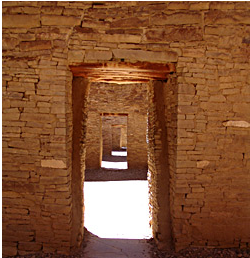Publication Date
8-10-2018
Abstract
Between about A.D. 850 and 1140, the archaeology of Chaco Canyon in northwestern New Mexico reveals the rapid construction of large communal structures where smaller settlements had existed previously and shows that the locality became the core of an extensive regional system in the Four Corners region of the northern Southwest integrated by formal trails, the circulation of nonlocal goods, and the sharing of ritual items. Researchers vigorously debate the role of increased sociopolitical complexity in this development, but less attention has been given to questions of sociocultural diversity and its impacts.
Guided by previous research suggesting the existence of sociocultural or biological diversity, this dissertation examines a set of related models that propose sociocultural diversity at site, community, and regional spatial scales by seeking to distinguish patterned stylistic variability in woven artifact manufacture with implications for understanding sociocultural diversity across the Chaco system. The concept of technological style, united with current research on social learning theory, provides the conceptual framework that connects ancient woven artifacts with learning networks, social interaction, identities, and diversity. Drawing on this body of theory, I conducted detailed technological analyses of over 1,100 coiled baskets, plaited mats, and plaited sandals from Chaco Canyon and multiple other sites.
This study’s findings provide evidence for site-scale diversity at Pueblo Bonito in Chaco Canyon, and Aztec West Ruin to the north. Community-scale diversity is suggested within Chaco Canyon between great houses and small sites. Pan-regional consistency in many technological stylistic features of basketry artifacts demonstrates a deep shared history of teaching and learning these technologies, but woven artifacts from Mesa Verde sites are most distinctive, and evidence also exists for differences between outlying communities.
The distribution of ritual basketry at Chaco Canyon and beyond suggests linkages between the social entities that maintained them, first at Pueblo Bonito and, later, at outlying communities. Diversity in ritual practice emerges as factor that likely both facilitated a shared Chacoan identity and integrated newcomers. Taken as a whole, the available evidence suggests the importance of tolerance of sociocultural diversity as integral to the successful maintenance of a heterogeneous Chacoan society.
Keywords
basketry, Chaco Canyon, identity, diversity, social learning, weaving, Southwest, Pueblo
Project Sponsors
National Science Foundation dissertation improvement grant BCS-0853134, NSF Grant BCS-0520579 to Paul Reed, Laurie Webster, and Jeffery Clark (for work on Aztec Ruins basketry), a Mellon Doctoral Fellowship at UNM, Hibben Fellowships at UNM, UNM’s Graduate Research and Development Grant, UNM’s Student Research Allocation Committee, the American Indian Graduate Center, the Clark Scholarship and Joe Ben Wheat Research Award from the University of Colorado, Boulder, Sigma Xi, and UNM’s Institute for American Indian Research
Document Type
Dissertation
Language
English
Degree Name
Anthropology
Level of Degree
Doctoral
Department Name
Anthropology
First Committee Member (Chair)
Patricia L. Crown
Second Committee Member
Wirt H. Wills
Third Committee Member
Timothy K. Lowrey
Fourth Committee Member
Laurie D. Webster
Recommended Citation
Jolie, Edward Alexander. "Sociocultural Diversity in the Prehispanic Southwest: Learning, Weaving, and Identity in the Chaco Regional System, A.D. 850-1140." (2018). https://digitalrepository.unm.edu/anth_etds/166

